Shah Ismail I (r. 1502-1524) led the armies of Iran against the numerically superior and firearms equipped invading horses of Sultan “Yavuz” (the Grim) Selim at the Battle of Chaldiran on August 23, 1514. The Italian nobleman and ambassador to Persia, Giosofat Barbaro, has provided a description of Shah Ismail’s troops in an 1873 publication based on his travels:
“…the flower of the Persian people, as the kings of Persia are not accustomed to give pay on the occasion of war, but to a standing force…Thus it is the Persian gentlemen, to be well brought up, pay great attention to horsemanship, and when necessity calls, go willingly to war…” (Josafa Barbaro (1873). Travels to Tana and Persia. London: Printed for the Hakluyt Society, p.58).
In the disastrous aftermath of the ensuing Ottoman-Safavid wars, much of Iran’s Azarbaijan province (including its provincial capital Tabriz), Armenia (known as the Iravan Khanate in Medieval Iranian sources) and the Caucasus fell under the occupation of the Ottoman Turks. What is clear is that, despite the prevalence Turkic speech among Shah Ismail’s Safavid court and the Turkmen Qizilbash warriors of his army, the Europeans (1) recognized the Safavids and their troops as belonging to the Iranian realm and (2) that the Ottomans were the mortal enemies of the Safavids.
Despite the defeat at Chaldiran, the Ottomans failed to conquer Iran. The Iranian army, though battered, lived to fight another day. Important military reforms which had begun at the time of Shah Tahmasp I (r. 1524-1576) reached their apogee at the time of Shah Abbas I (r. 1587-1629), especially in the latter’s success in finally implementing the full integration of firearms into the Safavid battle order. The latter task was assisted by the English brothers, Anthony and Robert Shereley. Vincenzo D’Alessandri a European visitor to Iran arriving in 1571, reported that: “Persians are tall and strong… commonly use swords, lances and guns on the battlefield…Persian Musketeers use their muskets so adeptly…they will draw the sword at times of necessity…muskets are slung to the back as to not interfere with the usage of bows and swords…their horses are very well trained and they [the Iranians] have no need to import horses…” [As cited in Amiri, M. (1970). Safarnameye Venezian dar Iran [The Travelogues of the Venetians in Persia]. Tehran: Entesharat-e Kharazmi, pp.448-449]. Despite fielding smaller numbers of troops, the reformed Safavid armies of Shah Abbas I defeated the Ottoman Turks and liberated Tabriz from Turkish occupation on October 21, 1603 (after 20 days of fighting). Note that the sources cited in this article thus far are clear that the Safavids are Iranians; they are consistently refered to as “Persians” in reference to their historical and cultural links to the wider Iranian mileau. Therefore, the fact that many of the Iranian Azarbaijanis had become Turcophone was simply another facet of their Iranian identity – Iranians are not limited to Persian-speakers only, as Iranian culture is multifaceted and characterized by diversity and synthesis within an Iranian cultural framework. Note the observations of a European traveler to Iran named Antonio Tenreiro in 1525 and his descriptions of the inhabitants of the city of Tabriz: “This city [Tabriz] is inhabited by Persians and some Turkomans, white people, and beautiful of face and person” [Ronald Bishop Smith (1970), The first age of the Portuguese embassies, navigations and peregrinations in Persia (1507-1524), Decatur Press, pp. 85-86.]. It should be noted that the Turkoman tribes cited above were religious followers of the Safavid dynasty (themselves originally of the Iranian pedigree but progressively Turkicized linguistically, hence of the Persianate civilizational realm). These had migrated from the Anatolian regions and became the military backbone of the early Safavid dynasty. It was these same Turcomens who had stood up with Shah Ismail against the Ottoman Turks in the Battle of Chaldiran in 1514. It is clear that the Ottoman Turks had intended to hold Tabriz and all of Azarbaijan under permanent occupation. In a letter written by Shah Abbas to Jalal e Din Mohammad Akbar (the powerful emperor of India and contemporary of Shah Abbas, whom the Iranian king always addressed as father) after the liberation of Tabriz, he had noted that the Ottomans in Tabriz had: “…200 cannon, 5000 musketeers…supplies lasting for ten years and much equipment for the holding of fortresses…” [Falsafi, N. (1965). Zendeganiye Shah Abbas Avval [The Life and Times of Shah Abbas the First] (6 Volumes). Tehran University, Volume IV, pp.22-23.].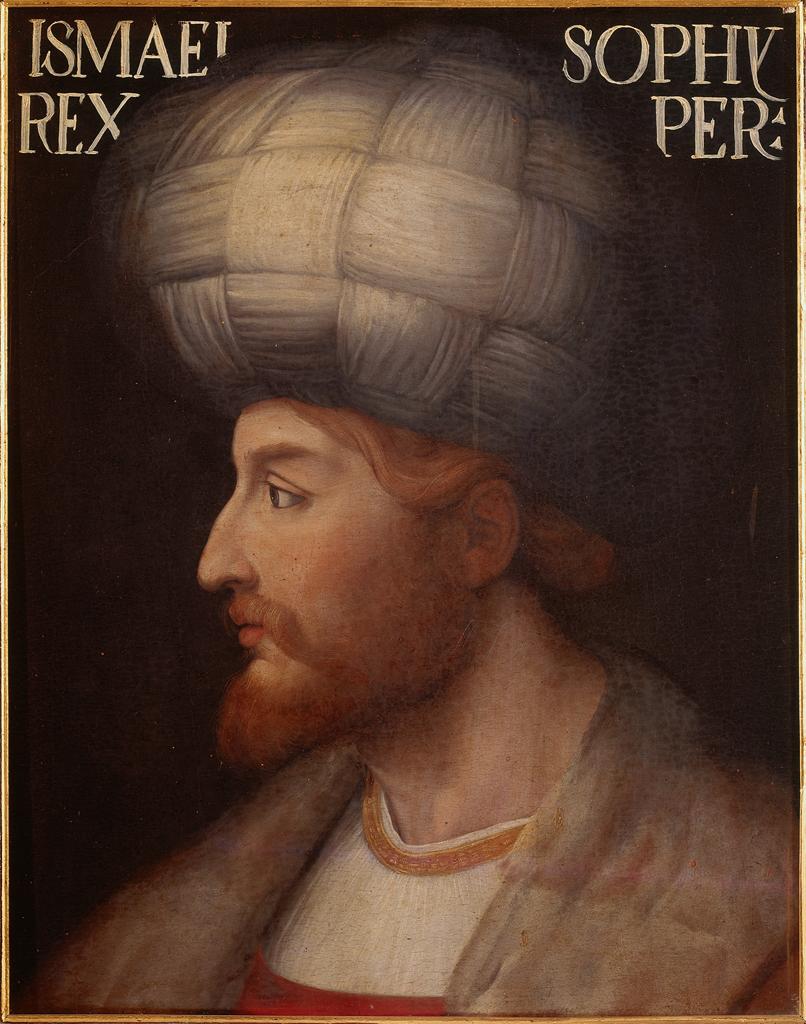
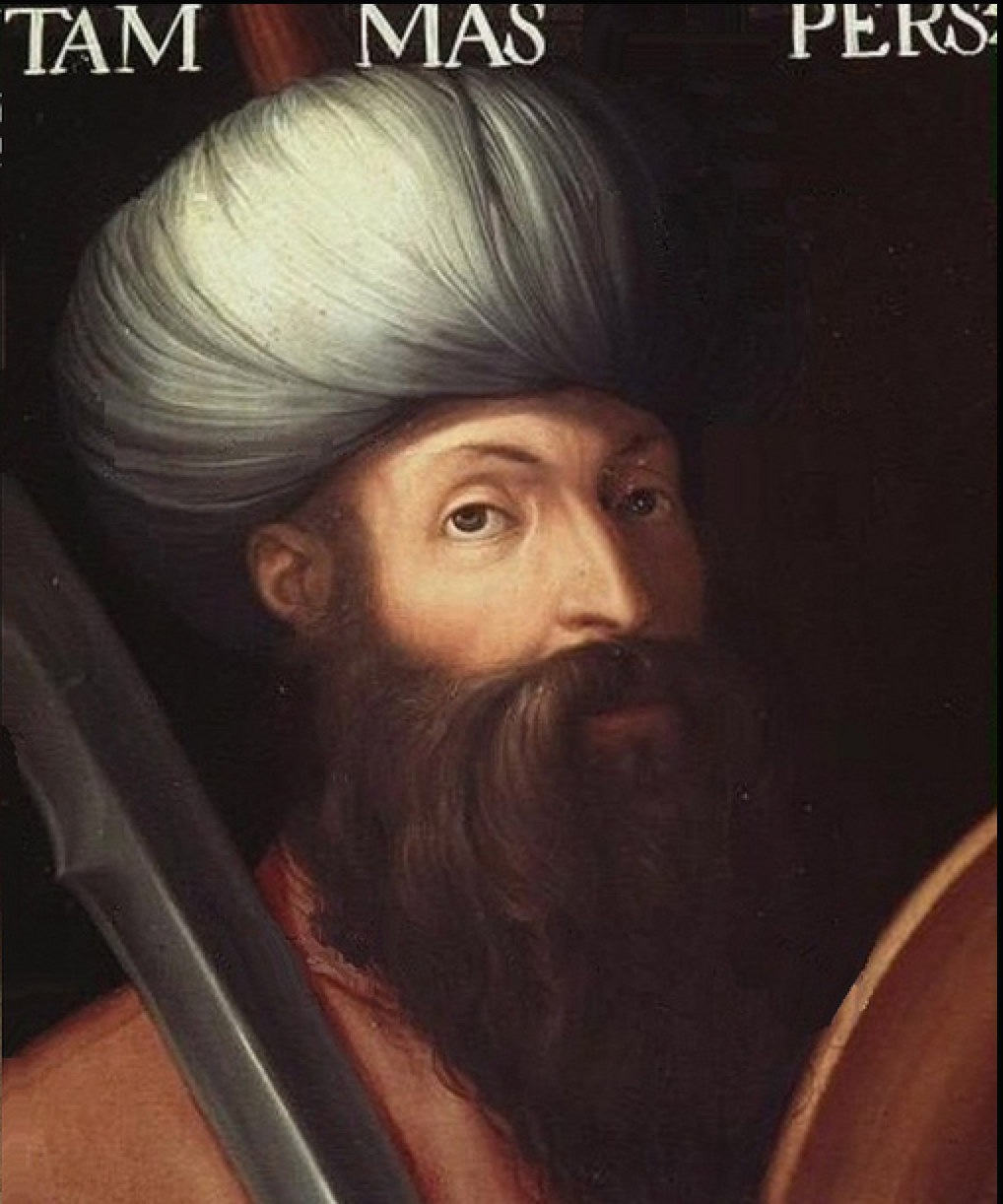 [Click to Enlarge] Son and successor of Shah Ismail, Shah Tahmasp (r.1524-1576). Note from the partially visible lettering that Tahmasp is also clearly identified as king of Persia. Ismail Commissioned a copy of the Iranian epic Shahname for his son (Savory, R. M. (1994). Land of the Lion and the Sun, in Lewis, B. (ed.), The World of Islam: Faith, People and Culture, Thames & Hudson, pp.245-271, as cited from pp.252) which was completed after Ismail’s death.
[Click to Enlarge] Son and successor of Shah Ismail, Shah Tahmasp (r.1524-1576). Note from the partially visible lettering that Tahmasp is also clearly identified as king of Persia. Ismail Commissioned a copy of the Iranian epic Shahname for his son (Savory, R. M. (1994). Land of the Lion and the Sun, in Lewis, B. (ed.), The World of Islam: Faith, People and Culture, Thames & Hudson, pp.245-271, as cited from pp.252) which was completed after Ismail’s death.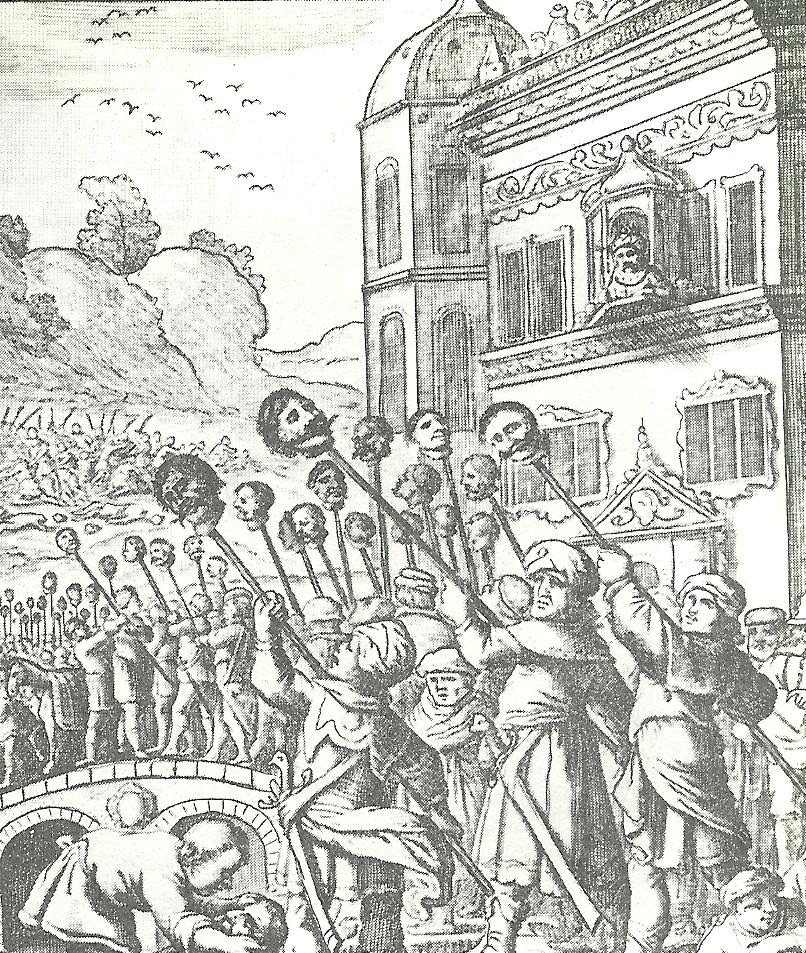 Rare drawing by a European traveler who witnessed the aftermath of the liberation of Tabriz by Shah Abbas I on October 21, 1603. Local Azari citizens welcomed the Iranian Safavid army as liberators and took harsh reprisals against the defeated Ottoman Turks who had been occupying their city. Many unfortunate Turks fell into the hands of Tabriz’s citizens and were decapitated (Picture Source: Matofi, A., 1999, Tarikh-e-Chahar Hezar Sal-e Artesh-e Iran: Az Tamadon-e Elam ta 1320 Khorsheedi, Jang-e- Iran va Araqh [The 4000 Year History of the Army of Iran: From the Elamite Civilizaiton to 1941, the Iran-Iraq War]. Tehran:Entesharat-e Iman, p.63).
Rare drawing by a European traveler who witnessed the aftermath of the liberation of Tabriz by Shah Abbas I on October 21, 1603. Local Azari citizens welcomed the Iranian Safavid army as liberators and took harsh reprisals against the defeated Ottoman Turks who had been occupying their city. Many unfortunate Turks fell into the hands of Tabriz’s citizens and were decapitated (Picture Source: Matofi, A., 1999, Tarikh-e-Chahar Hezar Sal-e Artesh-e Iran: Az Tamadon-e Elam ta 1320 Khorsheedi, Jang-e- Iran va Araqh [The 4000 Year History of the Army of Iran: From the Elamite Civilizaiton to 1941, the Iran-Iraq War]. Tehran:Entesharat-e Iman, p.63).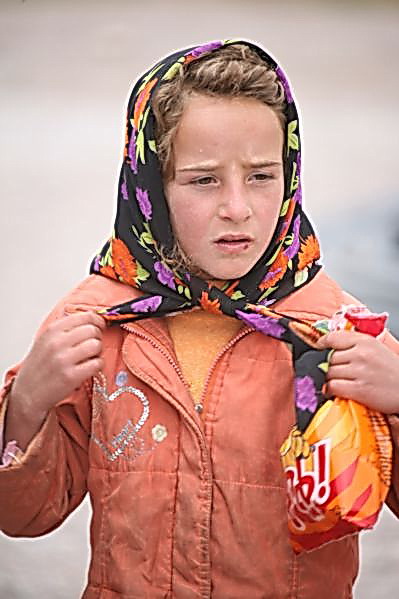 A girl from modern-day Ardabil (known as Abadan Piruz or Shahram Peruz in Sassanian times). There are numeorus historical references to a Pahlavi-based language in Iranian Azarbaijan, notably the Fahlaviyat, Tabrizi and and Azariyeh before the linguistic Turkification of the province. Examples include: (1) The Ottoman Turkish traveler Evliya Chelebi reports as late as 17th century that the majority of the women in [the city of] Maragheh conversed in Pahlavi or Middle Persian (2) Sadeqi has noted that “Pahlavi, Dari, Farsi and Dehqani” among the Iranian languages prevalent in Nakhchevan khanate in the Caucasus (Sadeqi, A.A. (2003). The conflict between Persian and Turkish in Arran and Shirvan. Iranian Journal of Linguistics, 18 (1), pp 1-12) (3) Ganjakets’i stating that Maragheh (Ganjakets’i, Kirakos (1986, Tr. with preface by R. Bedrosian), Kirakos Ganjakets’i’s History of the Armenians. New York: Sources of the Armenian Tradition, pp.197): “…was densely populated with Persians and a small number of Christians.”
A girl from modern-day Ardabil (known as Abadan Piruz or Shahram Peruz in Sassanian times). There are numeorus historical references to a Pahlavi-based language in Iranian Azarbaijan, notably the Fahlaviyat, Tabrizi and and Azariyeh before the linguistic Turkification of the province. Examples include: (1) The Ottoman Turkish traveler Evliya Chelebi reports as late as 17th century that the majority of the women in [the city of] Maragheh conversed in Pahlavi or Middle Persian (2) Sadeqi has noted that “Pahlavi, Dari, Farsi and Dehqani” among the Iranian languages prevalent in Nakhchevan khanate in the Caucasus (Sadeqi, A.A. (2003). The conflict between Persian and Turkish in Arran and Shirvan. Iranian Journal of Linguistics, 18 (1), pp 1-12) (3) Ganjakets’i stating that Maragheh (Ganjakets’i, Kirakos (1986, Tr. with preface by R. Bedrosian), Kirakos Ganjakets’i’s History of the Armenians. New York: Sources of the Armenian Tradition, pp.197): “…was densely populated with Persians and a small number of Christians.”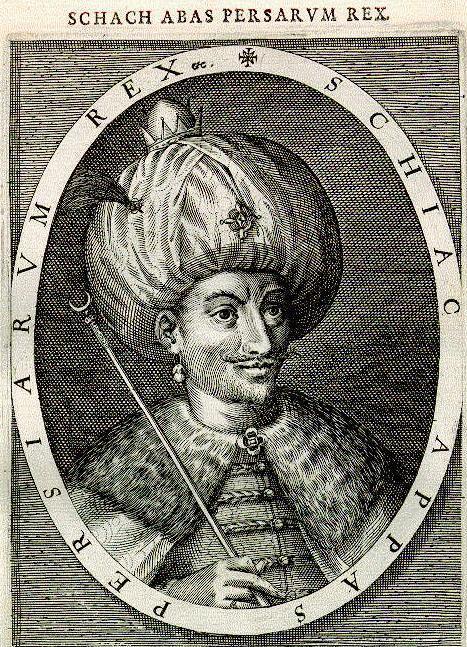 [Click to enlarge] Shah Abbas I (r. 1587-1629) as depicted in a European copper engraving made by Dominicus Custos citing him as“Schach Abas Persarum Rex” or “Shah Abbas the Great monarch of Persia”. Note how Custos makes a particular emphasis on linking Shah Abbas to the “Mnemona Cyrus” (the Memory of Cyrus the Great of Persia). His victories over the Ottomans weakened them against the Europeans to the West, and especially in the Balkans and Eastern Europe.
[Click to enlarge] Shah Abbas I (r. 1587-1629) as depicted in a European copper engraving made by Dominicus Custos citing him as“Schach Abas Persarum Rex” or “Shah Abbas the Great monarch of Persia”. Note how Custos makes a particular emphasis on linking Shah Abbas to the “Mnemona Cyrus” (the Memory of Cyrus the Great of Persia). His victories over the Ottomans weakened them against the Europeans to the West, and especially in the Balkans and Eastern Europe.



